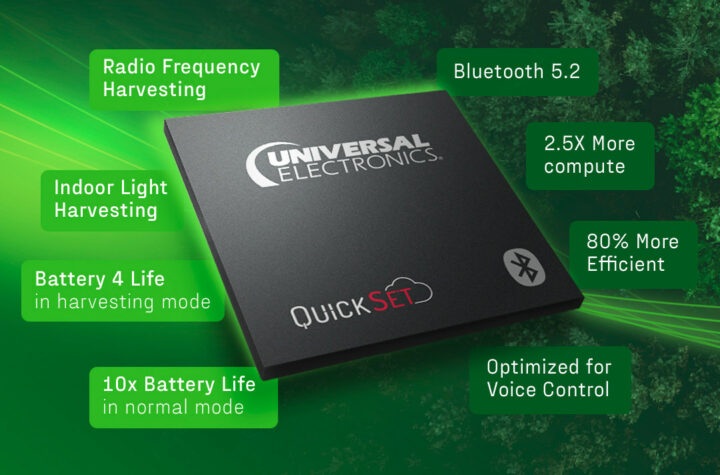Most people probably don’t mind changing batteries in remote controls every so often, but it contributes to e-waste especially if you’re not using rechargeable batteries, and I always find it’s pain as I don’t usually have stock, or don’t feel like waiting for several hours to recharge the batteries.
Universal Electronics Inc, or UEI for shorts, claims to have a solution with a family of QuickSet-certified chips using “Extreme Low-Power”, energy-harvesting and “high-performance technology” that would provide lifetime battery life to Bluetooth, voice remote controls. The main goal is “to help transition the world towards a more sustainable future, by reducing primary battery waste throughout the life of the product, which in turn reduces the cumulative CO2 footprint”.
We don’t have a lot of information about the chip, but the company provides some of the key benefits of the Bluetooth 5.2 SoC:
- Arm-based with Trustzone security
- Up to 2.5 times more processing power than current generation SOCs
- Up to 80% lower power consumption so that batteries can last up to 10 times longer, depending on the remote architecture, due to adaptive scaling of the supply voltage.
- Integrated energy harvesting that recovers energy already present in consumer homes, such as natural and artificial lights, radio frequencies from wireless devices, and other energy sources.
- Power management – Support for a wide range of energy storage and charging options with a configurable, ultra-efficient Power Management Unit (PMU) that enables “true self-powering”.
I’m not exactly sure why people writing press releases keep on using the meaningless expression “current/previous generation”, and it’s unclear what those are, even after checking out the company’s products page since I don’t see any other Bluetooth SoCs.
The built-in energy harvesting solution is optional, and there will be two versions at launch, the UE961 “extreme low-power” silicon with support for Bluetooth 5.2 LE connectivity, and UE962 adding energy harvesting capabilities. Later on, the company plans to introduce a multi-protocol version with an additional 802.15.4 radio that should probably be used for Zigbee, Thread, and/or Matter.
Thanks to TLS for the tip.

Jean-Luc started CNX Software in 2010 as a part-time endeavor, before quitting his job as a software engineering manager, and starting to write daily news, and reviews full time later in 2011.
Support CNX Software! Donate via cryptocurrencies, become a Patron on Patreon, or purchase goods on Amazon or Aliexpress





